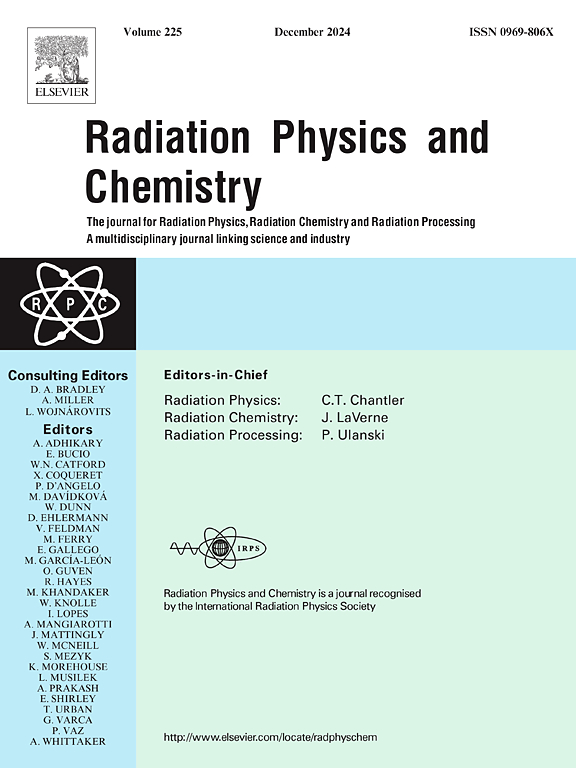Characterization of intraoral digital detectors: Comparative analysis in spatial and reciprocal domains across two different beam qualities
IF 2.8
3区 物理与天体物理
Q3 CHEMISTRY, PHYSICAL
引用次数: 0
Abstract
The transition from analog to digital systems in dental radiography is primarily driven by the technological advancements offered by digital detectors. This study evaluates the performance of three commercially available intraoral digital detectors—Eagle Digital Sensor, RVG 5200 Carestream Dental, and Schick Fona CDRelite—under two beam qualities: the standard RQA 5 quality (70 kVp, 21 mm Al) and a new proposed quality in this work (70 kVp, 12 mm Al) more applicable to dental practices. Detector air kerma (DAK) levels ranged from 10 to 500 μGy. The assessment included metrics in both spatial and reciprocal domains, measuring response linearity, noise spatial invariance, noise component analysis, Modulation Transfer Function (MTF), Normalized Noise Power Spectrum (NNPS), and Detective Quantum Efficiency (DQE). All detectors displayed linearity across beam qualities, though the fitting coefficients varied. Quantum noise was predominant across almost the entire DAK range studied, and MTF showed minimal variation across beam qualities. The spatial frequency for MTF 10 % was 11 lp/mm for the RVG 5200 and 10.5 lp/mm for the Eagle, while the Schick CDRelite reached this point at 5.5 lp/mm. In all systems, an expected decrease in NNPS values with increasing DAK was observed. The newly proposed beam quality slightly favored DQE values at comparable DAK levels. For the DQE at 5 lp/mm, the Eagle detector increased from 0.056 to 0.065, the RVG 5200 from 0.164 to 0.170, and the Schick CDRelite from 0.026 to 0.033. The optimal exposure conditions for all studied detectors were determined through DQE analysis.
口腔内数字检测器的特性:在两种不同光束质量的空间和互反域中的比较分析
牙科放射照相从模拟系统到数字系统的过渡主要是由数字探测器提供的技术进步驱动的。本研究评估了三种市上销售的口内数字检测器——eagle digital Sensor、RVG 5200 Carestream Dental和Schick Fona cdreli——在两种光束质量下的性能:标准RQA 5质量(70 kVp, 21 mm Al)和本研究中提出的一种更适用于牙科实践的新质量(70 kVp, 12 mm Al)。探测器空气克玛(DAK)水平为10 ~ 500 μGy。评估包括空间和互反域的度量,测量响应线性度,噪声空间不变性,噪声成分分析,调制传递函数(MTF),归一化噪声功率谱(NNPS)和检测量子效率(DQE)。尽管拟合系数不同,但所有探测器在光束质量上都显示线性。量子噪声在研究的几乎整个DAK范围内占主导地位,而MTF在光束质量上的变化最小。RVG 5200的MTF 10%的空间频率为11 lp/mm, Eagle为10.5 lp/mm,而Schick CDRelite达到了5.5 lp/mm。在所有系统中,观察到NNPS值随着DAK的增加而预期下降。新提出的光束质量稍微有利于DQE值在相当的DAK水平。对于5 lp/mm的DQE, Eagle探测器从0.056增加到0.065,RVG 5200从0.164增加到0.170,Schick CDRelite从0.026增加到0.033。通过DQE分析确定了各探测器的最佳暴露条件。
本文章由计算机程序翻译,如有差异,请以英文原文为准。
求助全文
约1分钟内获得全文
求助全文
来源期刊

Radiation Physics and Chemistry
化学-核科学技术
CiteScore
5.60
自引率
17.20%
发文量
574
审稿时长
12 weeks
期刊介绍:
Radiation Physics and Chemistry is a multidisciplinary journal that provides a medium for publication of substantial and original papers, reviews, and short communications which focus on research and developments involving ionizing radiation in radiation physics, radiation chemistry and radiation processing.
The journal aims to publish papers with significance to an international audience, containing substantial novelty and scientific impact. The Editors reserve the rights to reject, with or without external review, papers that do not meet these criteria. This could include papers that are very similar to previous publications, only with changed target substrates, employed materials, analyzed sites and experimental methods, report results without presenting new insights and/or hypothesis testing, or do not focus on the radiation effects.
 求助内容:
求助内容: 应助结果提醒方式:
应助结果提醒方式:


